Kerala State Road Transport Corporation
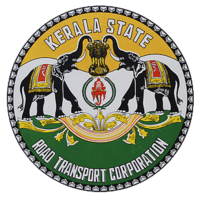 | |
| Public Sector Corporation under the Ministry of Transport, Government of Kerala | |
| Industry | Public Transport |
| Founded |
20 February 1938: Travancore State Transport Department (TSTD) |
| Headquarters |
Thiruvananthapuram (South Zone) Kochi (Central Zone) Kozhikode (North Zone) |
Areas served |
Kerala Tamil Nadu Karnataka Mahe |
Key people | Managing Director Tomin.J.Thachangary |
| Services |
Bus transport Courier Service |
| Revenue |
|
|
| |
| Subsidiaries | Kerala Urban Road Transport Corporation (KURTC) |
| Website |
www.keralartc.com www.keralartc.in |
Kerala State Road Transport Corporation (KeralaStatrRTC) is a state-owned road transport corporation in the Indian state Kerala. It is one of the oldest state run public bus transport services in India. The corporation is divided into three separate independent zones: South Zone, Central Zone and North Zone, with headquarters at Thiruvananthapuram, Kochi and Kozhikode respectively.
History
Travancore State Transport Department
The history of Kerala State Road Transport Corporation dates back to before the formation of Kerala, making it one of the oldest State-operated and managed public road transport services in the country. The Travancore State government, headed by King Chithira Thirunal Balarama Varma, decided to start the Travancore State Transport Department (TSTD) as it found that the existing system of public transport needed an overhaul. It was operated by private agencies and there was cut-throat competition between these agencies with profiteering being the sole motive. In order to prevent the public from being fleeced the government decided to introduce and regulate public transport in the State. A special committee for the reorganization of public transport was formed and it was decided to seek the services of an expert in this field. That brought E.G. Salter, who was Assistant Operating Superintendent of London Passenger Transport Board, to Travancore. He joined the committee on 20 September 1937 and began working on the project.[3][4][5]
Initially, the department imported 60 Commer PNF3 chassis from England and they were fitted with Perkins made Lynx diesel engines under the direct supervision of Salter. The bodies of the buses were built by the staff of the Travancore State Transport Department under the supervision of the Superintendent. Dewan C.P. Ramaswamy Aiyer insisted on using local wood to build the body. The bus body shop supervised by Salter was at Chakai which was later moved to Pappanamcode. The experimental design of the body created by Salter became the standard design of the rest of the buses.[6][7]
Most of the private operators on the Trivandrum-Kanyakumari route had to shut down their services with the route being nationalized. Many experienced drivers, conductors and inspectors lost their jobs. TSTD decided to recruit them. Out of 81 people applied for job in state transport 60 lucky people got job and they were selected by Salter. The archival records mention a proper selection process, which incidentally was the first-ever staff selection program for a State public sector enterprise. Nearly a hundred bachelor's degree holders were given appointments as Inspectors and Conductors.[8]
The official launch of the state road transport services was held on 20 February 1938. Maharaja Sree Chithira Thirunal inaugurated the service. He, along with members of his family, Col. Goda Varma Raja and other dignitaries travelled on the first bus through the Main Road to Kowdiar Square. Salter drove the bus, thereby earning the recognition of being the first driver of the State transport department. A fleet of 33 buses and a huge crowd joined in celebration as the bus carrying the Maharaja moved forward. On 21 February 1938 the first bus operated from Trivandrum to Kanyakumari.[9][10]
The early buses were like saloons with 23 soft leather seats. The entrance was through the rear with a passage in the middle. There were 10 first class seats in the front. The schedules, fares and bus stops were fixed and published. A parcel service was also started. People could use these buses to send goods through designated agents appointed by the government. These parcels were distributed to the addresses by the agents. Conductors had Khaki dress and white topi while the inspectors had Khaki dress and Khaki hat. Conductors had Ticket Machines at that time. The machine had a button, when pressed the ticket will come out with a ring of bell in the machine. Commer and Perkins buses were first but the Dodge, Fargo, Bedford and Chevrolet followed later.[6]
The TSTD operated on three routes, Trivandrum-Nagercoil, Nagercoil-Kanyakumari and the third, Nagercoil-Colachal. They were introduced on 21.2.1938 with 39 buses totally for all of the three bus routes as a whole. The minimum fare, for one mile, was half a chakram. The next slab was one chakram, while the first class tickets cost 50 per cent more of the basic fare. Children up to three years were allowed free travel, while those between three and 14 had to pay half the charge. There was no special charge for luggage that weighed less than 28 pounds. Anything between 28-56 pounds were charged four chakram and those between 56-112 pounds six chakram.[6][8]
The Motor Vehicle Act was passed in 1939. From modest beginnings of a small fleet of buses operating over three routes the department extended its activities and established a network of passenger services. The services were extended to Cochin in 1949 and to the Malabar in 1956.[6]
The Kerala State Transport Corporation
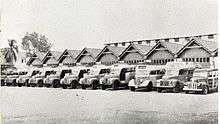
The Kerala State Transport Corporation (KSRTC) came into existence in March 1965. The decision came following the Road Transport Corporation Act that came into force in 1950. The Transport Department was converted into an autonomous corporation on 1 April 1965. The Kerala State road Transport Corporation was established by the government of Kerala by the notification dated, 15-3-1965. [8]
At the time of transfer there were 661 bus schedules and 36 lorry schedules. It possessed a fleet of 901 buses 51 lorries and 29 other vehicles. The new working of the corporation started with 30 new buses and 8 new lorries. 10 old buses and 7 old lorries and one tractor trailer were converted for other uses.[8]
The registration series KLX was exclusive for KSRTC. After 1 July 1989 KSRTC buses are registered under a dedicated RTO at Thiruvananthapuram with the registration series KL-15.[11]
The State government had issued a notification in 2012 suspending the issuance of new permits to inter-district buses while exempting the Kerala State Transport Corporation (KSRTC). The presumption then was that State-run services would step in and operate on these routes. However, it had led to a shortage of services from Kochi to several northern districts, Madhu Sivaraman, CPPR Director (research and projects) said, who conducted a study regarding choice between KSRTC and private buses.[12]
Fleet
The corporation has a fleet of 6241 buses consisting Volvo, Scania, Ashok Leyland, Tata Motors, Eicher Motors and minibuses.[13][11] The vehicles owned by KSRTC is registered under a dedicated RTO at Thiruvananthapuram with a registration series KL-15.
Fleet Numbering System
Even though KSRTC has a dedicated RTO (Regional Transport Officer) for registering its fleet, all the buses are provided with bonnet number internally. The transport corporation uses this serial numbers for addressing its fleet internally. The number can be seen adjacent to depot marking in the front of the vehicle.[14][15][16]
“RPE981” represents a typical fleet number. This number can be split into three parts – RP E 981,
- The first part “RP” indicates the “series” the vehicle belongs to. The series code is formed from the word “TRANSPORT”. Each series includes 1000 vehicles. In 60s KSRTC started giving serial number “T” for its buses; “R” series followed the initial 1000 buses, and then came “A” so on till “P” series. Repetitive letters and letter “O” were exempted. Later 2 latter combinations are used for naming the”series” of buses. Every 1,000th bus of each series is numbered by a multiple of 1000 indicating the total number of buses introduced by KSRTC.[14][17]
| T | 1962 - 1966 |
| R | 1966 - 1971 |
| A | 1973 - 1978 |
| N | 1979 - 1983 |
| S | 1983 - 1986 |
| P | 1986 - 1989 |
| TR | 1989 – 1993 |
| TA | 1993 – 1995 |
| TN | 1995 – 1997 |
| TS | 1997 – 2000 |
| TP | 2000 – 2004 |
| RT | 2004 – 2006 |
| RR | 2006 – 2008 |
| RA | 2008 – 2010 |
| RN | 2010 – 2012 |
| RS | 2012 – 2015 |
| RP | 2015 - 2016 |
| AT | 2016 - |
- The second part, “E” in the example denotes the KSRTC workshop where the body work is done. This second part will not be present in buses that are purchased as fully built units and outsourced bodywork. KSRTC owns 5 workshops - one central and 4 regional.[17]
| Code | Workshop |
|---|---|
| C | Central Workshop, Pappanamcode, Thiruvananthapuram |
| A | Regional Workshop, Aluva |
| E | Regional Workshop, Edappal |
| K | Regional Workshop, Kozhikode |
| M | Regional Workshop, Mavelikkara |
- The third and last part is the vehicle number of the series. Last vehicle of each series - 1,000th bus is numbered by a multiple of 1000 indicating the total number of buses introduced by the Corporation.
In addition to this there is “TE” series specifically given to almost 144 buses built in Edappal Regional Workshop during the period of 1997 to 2003. Their depot vehicles are numbered in "D" series, while the Oil Tankers are numbered in "TT" series. KSRTC is also having a couple of Ambulances with a special series “AV” Buses procured under the scheme of JnNURM is denoted by a special series “JN”[17]
Types of Services
Garuda Maharaja
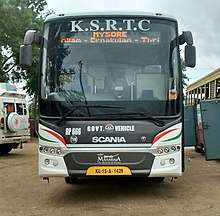
Introduced in 2016 Garuda Maharaja is the flagship service of KSRTC. These Luxury AC Semi Sleeper service are operated with Scania Metrolink HD 13.7 meter coaches. Designed for superior ride quality, these buses have reclining seats with footrest and calf support, radio and TV in front and middle. Value added services include a water bottle and blanket. KSRTC operates Garuda Maharaja Buses on long distance interstate routes. Currently majority of these buses are operated by Thiruvananthapuram depot in Thiruvananthapuram – Bangalore route.[18][19][20]
Garuda King Class
Premium service operated using AC Volvo Multi Axle. These services have amnesties similar to Garuda Maharaja.
KSRTC launched Volvo multi axle services in 2014 with 10 Euro III Volvo 9400 XL B9R.[21]
Garuda Sanchari
KSRTC operates bi-axle buses of Volvo make as Garuda Sanchari. "Sanchari" translates to "passenger" in Malayalam.
This service was introduced by K.B. Ganesh Kumar in 2002. First vehicles, two Volvo Euro III B7R Mark1 (TP620 & TP621) were the very first Volvo buses introduced by a STU. One bus operated by TVM Depot in Trivandrum – Palakkad route and the other one operated by Ernakulam Depot in Trivandrum - Kozhikkode route. These buses were in service till 2008. In 2008 KSRTC acquired 3 Volvo 9400 B7R Mark III and continued Garuda services.[22][23][24][25][26]
Super Deluxe Air Bus
These are non-air conditioned 2+2 push back services. The white colored buses with streaks of the tri-color on the sides have facility for charging mobile phones and laptops. The buses also equipped with real axle air suspension. Buses are built on Ashok Leyland & Tata chassis. Standing passengers is not allowed in deluxe buses.[27][28]
Kannur depot operates the oldest deluxe service of KSRTC between Kannur and Thiruvananthapuram. Started in 1967, this deluxe service inspired filmmakers to create the first road movie of Malayalam cinema "Kannur Deluxe", which is also the nickname for the same service. Major portions of the film were shot inside the bus.[29][30][31][32]
Minnal
Long distance limited stop deluxe buses. The service is scheduled as night riders and reaches the destination by the morning, in the mean time it is also expected to beat the trains running on the route. The service uses bypass roads to avoid traffic jams and to save time. The maximum stops allowed for Minnal service is only 8. The Buses are red and white in color and designs of lightning bolts are painted on them. "Minnal" translates to "Lightning" in Malayalam. The 41 seater buses feature 2+2 reclining seats and rear axle air suspension. The services have fares on a par with the super deluxe service of the transport utility.[33]
The service was Introduced in 2017 June when Managing Director M.G. Rajamanikyam IAS was in office. Red & white color scheme is chosen over the initially planned dark blue theme, considering the visibility in night hour rides.[34] The buses are built in-house on Ashok Leyland 160 hp Viking 222’’ (ALPSV 4/186) BS III and Tata LPO 1512c EX/58 BS III air suspension chassis.[35][36]
Sabari Air Bus
Sabari Air Bus was introduced in 2016 Sabarimala season as special service for pilgrims. The buses feature forest themed livery to spread awareness about the need to protect eco – sensitive Periyar reserve forest. The buses have facilities similar to deluxe buses and same fare is collected. After the Sabarimala season these buses ply all around Kerala in addition to interstate services. These buses are built on Ashok Leyland BS III Viking 160 hp 222’’ (ALPSV 4/186) and Tata LPO 1512c EX/58 BS III air suspension chassis.[37][38]
Super Express Air Bus
Green and yellow colored buses with a paint job inspired from "Chundan vallam". Even though the features of the buses are same as of deluxe air bus, the fare charge is lower in super express buses. Super Express has more number of stops than deluxe buses and standing passengers are allowed in this service.[39]
The current fleet has buses built in-house on Ashok Leyland 160 hp Viking 222’’ BS III (ALPSV 4/186) chassis and Tata LPO 1512c EX/58 BS III air suspension chassis. Earlier the corporation had 12 meter super express buses built on Ashok Leyland 12M (ALPSV 4/106) and Tata 1612/59 chassis in the fleet.
Super Fast Passenger (SFP)
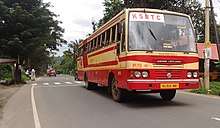
These are non - air conditioned services with 3+2 seating layout which run as intercity services in long routes. The buses themed red and yellow colors. Super Fast buses would stop at lesser number of stops compared to Fast Passengers, but has more stops than a Super Express bus. Buses used for this service are built on Ashok Leyland, Tata & Eicher chassis.[39]
Superfast buses made their appearance in the early 1992. These services were touted to be a faster alternative to the then predominant Fast Passenger Services.
Sandeshavahini
These are essentially re-colored superfast buses carrying water conservation messages. "Sandeshavahini" translates to "messenger" in Malayalam. The buses have a mix of blue and green color to denote water and carry messages on water conservation, against misuse of water, and ways to combat drought. The buses also have provisions to stock pamphlets, posters, and other publicity materials to be distributed among public.[40]
KSRTC introduced these services in 2017 March with 15 buses, one for each district except Thiruvananthapuram which has two. KSRTC and the state disaster management authority jointly designed the bus. The bus bodies were fabricated at KSRTC’s Edappal regional workshop on Eicher 20.15 N LPO BS III and Ashok Leyland BS III 160 hp Viking 222’’ (ALPSV 4/186) chassis.
Fast Passenger (FP)
These are non-air-conditioned services with 3+2 seat configuration that runs in intercity routes. The livery of Fast Passenger is inspired from "Chundan Vallam" with Red and Yellow colors. Fast passengers have stops less than ordinary service. The buses are built on chassis provided by manufactures like Tata, Ashok Leyland and Eicher.
Limited Stop Fast Passenger (LSFP)
LSFP service operates as FP bus that only stops at super fast stops. Fare class is same as FP, but fare stages are different therefore there could be difference in fare compared with FP buses, for the same travel distance. This service slot in between fast passenger and super fast passenger services.
Rajadhani/ Point to Point
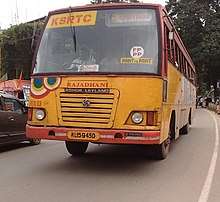
This is nonstop FP service. Fast passenger fare is inducted. Rajadhani buses have a colorful livery and operate in Thiruvananthapuram, Calicut and Wayanad districts.[41]
Rajadhani was introduced in Trivandram district as ring road service in 2012. In 2013 same service was introduced in Malabar region connecting Calicut and Wayanad districts.[42][43][44]
Ordinary
This is the most basic service of KSRTC. These buses are colored in red and yellow. Buses have bench seats with 3+2 or 2+2 layout. Usually the buses which completed super class permits are converted and used for ordinary service.
Town to Town
Town to Town or TT services operates with far less stops and ordinary fares are charged.[45][46]
KSRTC introduced "Town-to-Town" bus service in the mid-1990s. Back then those were Fast Passenger services, which operated at fixed intervals between two - or more - towns. These buses would stop only at limited number of stops. The TT revolution continued across the state, and many more sectors saw the introduction of such services. In 2000s Fast Passenger buses were replaced by Ordinary service on TT routes, and they improved KSRTCs stance during the period.
Ananthapuri Fast/ City Fast
Ananthapuri Fast is the brand for of City Fast buses that operate in Thiruvananthapuram City. Ananthapuri Fast buses have white and blue colored designs different to Malabar or Venad buses. City fast buses are operated in Ernakulum district too. City Fast buses have a slightly higher fare than ordinary.[47]
Limited Stop Ordinary
Limited Stop Ordinary buses are same ordinary buses with lesser number of stops. There is no difference with ordinary fare.
The introduction of Limited Stop Ordinary buses came in the mid-1990s. These services were faster than ordinary buses, but slower than Fast Passenger buses.
Malabar/ Venad/Thiru Kochi
These are originally introduced as limited stop ordinary services with a different livery introduced compete with a much modern private sector buses and to improve KSRTCs stance in public transport. Nowadays these buses also used for ordinary service.[48][49][50]
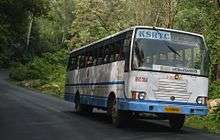
Venad services were introduced in July 2005. Venad buses were branded Limited Stop Ordinary Services. New buses were painted in a catchy white and blue livery, with Venad written on the bus in Orange colour. New buses were inducted to operate ordinary services. These branded services - Venad and Ananthapuri - had a variety of advantages over normal buses. These buses were painted in distinct liveries, had two doors (compared to only one in normal buses at that time), and had better seats and interiors, and a single-piece windshield for the driver. The bus had an ergonomic ‘all-steel body’ with a seating capacity of 53 persons. The low footboard was another feature. Body of all buses were built at in-house units & these services proved to be popular with the public.[51]
KSRTC introduced a couple of Venad buses in northern districts Kerala as well. However, Venad was a name typically associated with the southern part of Kerala. Venad buses were renamed as "Malabar" in the latter half of 2007.
AC Low Floor Bus
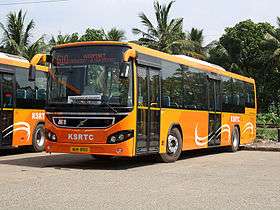
KSRTC operates air conditioned low floor buses in city and intercity routes. A bus stops at all Fast Passenger stops. The buses are acquired under JNNURM. Currently Volvo B7R LE & 8400 BS IV buses are used for this service.[52][53][54][55]
Non AC Low Floor/Semi Low Floor Bus
KSRTC operates non air conditioned buses in small routes. The buses are purchased under JNNRUM scheme. Low floor buses stops at all Fast Passenger stops. Currently KSRTC fleet have Ashok Leyland RESLF BS III which was procured during JNNURM Phase 1 in addition to Ashok Leyland 225 hp 12M FESLF & Tata Starbus Urban 9/12 BS III built on 1618 SLF by Marcopolo and ACGL.[56][57][58][59]
Double Decker Buses
Kerala SRTC operates double decker service in Thiruvananthapuram and Ernakulam districts. Ordinary fare is collected in double deckers. These are Ashok Leyland Titan (BS III 123 kW) with bonnet numbers RN766 and RN765.[60][61][62][63]
Double-decker buses came to India as early as 1937, when E.G. Salter, the Superintendent of the Travancore State Transport Department imported some double-deckers. KSRTC also used one of the original Routemasters in Kochi to service a single route from Palarivattom to Willingdon Island from the 1960s till the late 1970s. In a celebrated case, the courts, faced with an alleged defalcation of payment by the Kerala State Road Transport Corporation, ordered seizure of its most famous property — the Kochi double-decker — till the debt was cleared.[64]
Thiruvanathapuram originally had 15 double decker buses, serially numbered from DD1 to DD15. These were original British Leyland made with body built at KSRTC Central Workshop in Thiruvananthapuaram. These 15 buses were semi automatic and had no clutch. The last 5 buses were later moved to Eranakulam district. KSRTC launched two double decker buses with serial number given TR555 and TR666 in the 1990s.[65][66][67][68]
Articulated Buses
KSRTC owns an Ashok Leyland Vestibule (BS III 123 kW) bus which is operated in Thiruvananthapuram district. Passengers are charged with ordinary fares in this service too.[69]
Earlier there were Road trains in Trivandrum during 70s and 80s. There were also trailer buses with the tractor unit built by Ashok Leyland and the trailer by Allwyn.[62]
Discontinued Services
Terraplane
Terraplane was the flagship luxury service of KSRTC in 1970s. The nonstop service operated between Thiruvananthapuram and Ernakulam. Introduced by R. Balakrishna Pillai, who was the transport minister then, this service even had onboard toilet facility. The service facilitated with reservation system had tickets similar to flights. Two Ashok Leyland buses with bonnet numbers A555, A666 & a spare super deluxe bus numbered 4000 were used for the service. However it was banned from roads by court order due to higher accident rates.
Lightning Express
"Lightning Express" was the brand name for long distance limited stop services operated by KSRTC in the 1990s. The buses had a silver colored paint job. This service later converted to Volvo service with timings remaining the same.[70][71][72]
White Express
White and Red colored buses with chundan-style design operated in the 1990s.
Silver Line Jet
Silver line jets were introduced in 2015 as a spiritual successor to lighting express bus service. These services had limited stops across Kerala. Amenities included push back seats, CCTV camera, Wi-Fi and charging points for laptop and mobile phones. These services later stopped due to low ridership. Absence of air suspension and fares higher than deluxe buses aere considered to be the reasons. The 41 seater buses were fabricated in-house on Ashok Leyland BS III 160 hp Viking 222’’ (ALPSV 4/186) and Eicher 20.15 N LPO BS III chassis.[71][72][73][74][75]
Pink Bus
KSRTC launched these ladies only city fast services in Thiruvananthapuram district in 2017. The buses had only women conductors. Two old Ashok Leyland 160 hp Viking BS III 222’’ (ALPSV 4/186) super fast buses were used for this service. The buses were also themed in pink. However Pink bus failed to attract passengers.[76][77]
Mini Bus
The minibus service of KSRTC, introduced in 2003, was the first of its kind to be adopted by any transport corporation in the country. Though they had a capacity of only 25 to 30 seats, those buses were ideal for certain routes and stopped at places desired by the passengers. However, they were stopped as the buses were deemed less durable.[22][78]
Ananthapuri Air Bus
Introduced in 2005 at Thiruvananthapuram City, theses service is a predecessor to the low floor buses. With two doors and a long body, these buses could carry almost twice the number of passengers other buses carry. Its introduction was aimed at providing a better travel to the tourists travelling in the city. This was a semi low floor (635mm), rear engine, and non air-conditioned bus by Ashok Leyland on Panther chassis (ALPSR 3/22) with body built by Irizar – TVS.[79] With H series turbocharged engines conforming to BS II emission standards the 42 seater buses also had front and rear air suspension. KSRTC had a total 4 of them with serial numbers RT599, RT600, RT601, and RT602. These buses had dark blue lines on white background paintjob.[80][22]
AC Air Deluxe
KSRTC had a short lived AC service launched in 2005. After the entry of first ever Volvo buses the next set of AC buses rolled by KSRTC was a fleet of 10 fully built AC buses. 5 buses from Tata built by Popular and another 5 from Ashok Leyland built by Irizar TVS. The TATA buses were built on LPO 1616/62 BS II chassis with engine driven AC (DDAC) while the AL chassis’s were 177 hp 12M BS II (ALPSV 4/86) with AC driven by slave engine.
In the end of 2007 KSRTC added 20 Tata Globus 45 into its fleet. The buses with tri-color streaks on white background had pushback seats and facility for recharging mobile phones.[81]
Kerala Urban Road Transport Corporation
In November 2014, Kerala Urban Road Transport Corporation (KURTC), with headquarters in Kochi, was formed to operate low-floor buses which are procured with the financial assistance from the Jawaharlal Nehru National Urban Renewal Mission (JNNURM).[82]
The 314 low-floor buses already procured are to be brought under this newly formed subsidiary (KURTC). With 400 low-floor buses to be procured for extending services to 12 more districts in the State under JNNURM scheme 2013-14, the number of these sleek modern buses is to go up to 767.
Zones
As of July 2018 KSRTC has three independent zones with each zone headed by zonal officers provided with self-administrative powers.[83][84][85]
| Zone name | Districts | Headquarters |
|---|---|---|
| South Zone | Thiruvananthapuram, Kollam, Pathanamthitta | Thiruvananthapuram |
| Central Zone | Alappuzha, Idukki, Thrissur, Kottayam, Ernakulam | Kochi |
| North Zone | Malappuram, Palakkad, Kozhikkode, Wayanad, Kannur, Kasargod | Kozhikode |
Thiruvananthapuram zone which includes three districts has more buses. KSRTC has a monopoly over ordinary bus services in Thiruvanathapuram district. Meanwhile, North zone that includes 6 districts has 945 buses and majority of it are long distance buses.[86]
Depots and workshops
KSRTC has 28 depots, 45 sub depots, 19 operating centres, 28 station master offices, 5 workshops and 3 staff training colleges spread throughout the Kerala.[87] In 1995 Kerala State Road Transport Corporation ventured into the technical education field by establishing an engineering college named Sree Chitra Thirunal College of Engineering at Pappanamcode on its Central Workshop premises.
KSRTC also has 28 Station Master (SM) Offices at Ambalapuzha, Ayoor, Eenchakkal, Ernakulam Jetty, Ettumanoor, Iritty, Kadakkal, Kaliyakkavila, Kuthiyathode, Malayilkeezh, Mundakkayam, Nagarcoil, Ochira, Pattambi, Pothencode, Puthenkurishu, Tirur, Valanchery, Varkala, Vytila Hub and also have 3 staff training colleges in Trivandrum, Ernakulam and Edappal . [87]
Fares
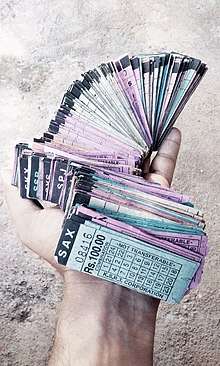
KSRTC uses fare-stage system for calculating fares.[88][89]
| Service Class | Minimum Fare | Rate per km for travel above minimum fare |
|---|---|---|
| City/Ordinary | Rs.8 | 70 paise |
| City Fast | Rs.8 | 75 paise |
| Fast Passenger/LSFP | Rs.11 | 75 paise |
| Super Fast Passenger | Rs.15 | 78 paise |
| Super Express | Rs.22 | 85 paise |
| Super Deluxe | Rs.30 | 100 paise |
| Luxury/Hi-tech and AC | Rs.44 | 120 paise |
| Garuda Sanchari/Biaxle Premium | Rs.45 | 145 paise |
| Garuda Maharaja/ Garuda King Class/ Multi-axle Premium | Rs.90 | 145 paise |
| A/C Low Floor | Rs.20 | |
| Non A/C Low Floor | Rs.10 |
Historical Fares
Half a Chakram was the minimum fare in 1938. The first class tickets had cost 50% more than the coordinating rate. During that period free travel was allowed for children up to 3 years and only half the fare was charged for children until age 14. There were no luggage tickets, but when the luggage weighed more than 28 pounds up to 56 pounds, a fee was assessed for 4 chakras. Passengers with luggage that weighed more than 56 pounds were assessed a fee of 6 chakras up to 112 pounds and above. As the Chakram had triple the value of a 100 rupee currency note today, the cost of travelling was comparatively higher during those days.
Trivia
References
- ↑ "How poor operational efficiency bleeds India's public bus transport undertakings". Hindustan Times. 27 October 2017.
- ↑ "Key Financial Ratios of SRTUs during March 2015 and March 2016". Open Government Data (OGD) Platform India. 19 January 2018.
- ↑ [https://web.archive.org/web/20150414040442/http://www.natgeotraveller.in/web-exclusive/web-exclusive-month/kerala-bus-journey/ Archive
- ↑ "Briton to co-ordinate indian transport". Archive.commercialmotor.com. 1937-08-27. Retrieved 2018-06-16.
- ↑ Nagam Aiya, V (2011) [1901]. Travancore State Manual. 1. Nabu Press.
- 1 2 3 4 PRADEEP, K. (2014-02-19). "When the buses drove in". The Hindu. ISSN 0971-751X. Retrieved 2018-07-31.
- ↑ "British Oilers inaugurate State-owned Service in India | 21st January 1938 | The Commercial Motor Archive". archive.commercialmotor.com. Retrieved 2018-07-31.
- 1 2 3 4 "KeralaSRTC::History". www.keralartc.com. Retrieved 2018-07-31.
- ↑ "Public Road Transport Service in Kerala Turns 77". NDTV.com. Retrieved 2018-07-31.
- ↑ "Public road transport service in Kerala turns 77". www.deccanchronicle.com. Retrieved 2018-07-31.
- 1 2 "Kerala State Road Transport Corporation buses get new registration series - Times of India". The Times of India.
- ↑ Paul, John L. (2016-12-09). "Concern over decline in number of inter-district buses". The Hindu. ISSN 0971-751X. Retrieved 2017-10-02.
- ↑ "KSRTC Directory". Keralartc.com. Retrieved 2018-06-16.
- 1 2 "Kerala Motor Vehicle Department".
- ↑ "KSRTC's fleet number: Demystified". www.platform7.in. Retrieved 2018-08-12.
- ↑ Bhakthan, Sujith (2015-07-31). "Serial Numbers Given For KSRTC Buses". Aanavandi Travel Blog. Retrieved 2018-08-12.
- 1 2 3 "KeralaSRTC::Vehicle search". www.keralartc.com. Retrieved 2018-08-12.
- ↑ Radhakrishnan, S. Anil (21 April 2016). "KSRTC all set to roll out 18 Scania buses". The Hindu.
- ↑ "27 new KSRTC buses yet to hit the road - Times of India". The Times of India. Retrieved 2018-07-30.
- ↑ "KSRTC not take in more Scania buses". Deccan Chronicle. 25 March 2018.
- ↑ Radhakrishnan, S. Anil (10 October 2013). "KSRTC to buy 10 Volvo multi-axle buses". The Hindu.
- 1 2 3 "The Hindu : In top gear". www.thehindu.com.
- ↑ "The Hindu Business Line : KSRTC plans to ply luxury buses". www.thehindubusinessline.com.
- ↑ "Forced Facelift Brings Fortune To Kerala's Public Transport". The Financial Express.
- ↑ Paul, John L. (6 February 2013). "KSRTC misses the bus as Karnataka rakes in money". The Hindu.
- ↑ "KSRTC plans online reservation". The Hindu. 18 December 2008.
- ↑ "Thirty new buses in KSRTC fleet". The Hindu. 2008-08-29. ISSN 0971-751X. Retrieved 2018-07-31.
- ↑ Correspondent, Special (10 October 2013). "Super Deluxe buses to ply inter-State in Kerala". The Hindu.
- ↑ "47yrs Kannur deluxe still ksrtcs ambassador". Deccan Chronicle.
- ↑ "കണ്ണൂര് ഡീലക്സിന് 47 വയസ്". www.mathrubhumi.com.
- ↑ "സിനിമയിലെ സൂപ്പർതാരങ്ങളെ വരെ മോഹിപ്പിച്ച താരത്തിന് 51ന്റെ നിറയൗവനം". ManoramaOnline.
- ↑ Vijayakumar, B. (5 July 2015). "Kannur Deluxe: 1969". The Hindu.
- ↑ "'Minnal' not to make unscheduled stops". The New Indian Express.
- ↑ "Minnal fleet to flaunt white and red colours - Times of India". The Times of India. Retrieved 2018-07-30.
- ↑ "In a race against time, KSRTC launches 'Minnal' buses". The Hindu. 28 June 2017.
- ↑ "KSRTC 'Minnal' services from today". The New Indian Express.
- ↑ "KSRTC launches Sabari Express for Sabari Mala – CV news". www.cvnews.in.
- ↑ James, Anu. "KSRTC introduces Sabari Express for Ayyappa devotees this Sabarimala season". International Business Times, India Edition. Retrieved 2018-07-30.
- 1 2 "KSRTC allows standing passengers on Super Class buses| Ksrtc standing passengers amendment | Mathrubhumi Online". english.mathrubhumi.com.
- ↑ &, Staff Reporter (2017-04-13). "Sandeshavahini buses flagged off". The Hindu. ISSN 0971-751X. Retrieved 2018-07-30.
- ↑ "right on track". www.newindianexpress.com. Retrieved 2018-07-30.
- ↑ "CM flags off Rajadhani bus service - Times of India". The Times of India. Retrieved 2018-07-29.
- ↑ yentha.com. "'Rajadhani' Services Flagged Off By CM - Trivandrum News | Yentha.com". www.yentha.com. Retrieved 2018-07-30.
- ↑ Daily, Online editor of Siraj. "KSRTC Rajadhani service in Wayanad - Calicut Sector". www.sirajlive.com. Retrieved 2018-07-30.
- ↑ "Kerala State Road Transport Corporation to start more services linking Malappuram - Times of India". The Times of India.
- ↑ "Town-to-Town: The revolution that changed KSRTC, forever..." www.platform7.in.
- ↑ "50 more Ananthapuri Fast bus services". The Hindu. 30 January 2009.
- ↑ "KSRTC moots Venad series buses in city". The Hindu. 27 August 2008.
- ↑ "Thiru-Kochi bus service soon to get 'city fast' tag - Times of India". The Times of India.
- ↑ "KSRTC's 'Malabar' service evokes good response". The Hindu. 17 March 2008.
- ↑ "Kochi low floor ac buses in dockyard". Deccan Chronicle.
- ↑ Govind, Biju (24 April 2015). "Low-floor bus services begin today". The Hindu.
- ↑ "Non-AC JNNURM buses 'vanishing'". The New Indian Express.
- ↑ "JnNURM". BESTpedia.
- ↑ "'JNNURM buses for urban transport'". The New Indian Express.
- ↑ Radhakrishnan, S. Anil (17 November 2009). "Low-floor AC buses under JNNURM launched". The Hindu.
- ↑ "KSRTC adds 10 more tata marcopolo buses to its fleet". www.motorindiaonline.in.
- ↑ Sharma, Bharadwaj. "Ashok Leyland Bags Orders for 4,000 Buses worth ₹1, 500 crore, Shares Soar". International Business Times, India Edition.
- ↑ Radhakrishnan, S. Anil (25 January 2015). "The first batch of JNNURM buses for 12 districts arrives". The Hindu.
- ↑ "Angamaly's own PM, a KSRTC double decker bus, rules the road". Mathrubhumi. 2 May 2018. Retrieved 29 July 2018.
- ↑ "Double-decker service for techies - Times of India". The Times of India. Retrieved 29 July 2018.
- 1 2 "Double-decker bus service brings loss to KSRTC - Times of India". The Times of India.
- ↑ Reporter, Staff (15 February 2011). "KSRTC to begin double decker service in Kochi". The Hindu.
- ↑ "The last running "Leyland Comet DD" will now be a history. Will Ash Ley save him? – CV news". www.cvnews.in.
- ↑ "A Historic Ride on India's First Double-Decker Buses". Nat Geo Traveller.
- ↑ "THIRUVANANTHAPURAM Updates- Central World Mall, Pattoor opens in August 2018 - Page 41". www.forumkeralam.in.
- ↑ "75 years on the 'Double' - Feature - Autocar India". www.autocarindia.com.
- ↑ "History on wheels - pride of the roads". The Hindu. 27 January 2006.
- ↑ "കെഎസ്ആര്ടിസിയിലെ ഏക വെസ്സ്റ്റിബ്യൂള് ബസ് തിരുവനന്തപുരം ജില്ലയ്ക്ക് സ്വന്തം; വൈറലായി ചിത്രങ്ങൾ ; ആറ്റിങ്ങൽ - കിഴക്കേക്കോട്ട റൂട്ടിൽ ബസ് സർവീസ്". metromalayali.in.
- ↑ "Speed governors can save Rs.87.54 crore for KSRTC". The Hindu. 2006-10-01. ISSN 0971-751X. Retrieved 2018-07-30.
- 1 2 "KSRTC to start lightning express model bus services". www.archive.asianetnews.tv. Retrieved 30 July 2018.
- 1 2 "KSRTC plans add scania its luxury fleet". www.deccanchronicle.com. Retrieved 30 July 2018.
- ↑ "Kerala SRTC taking a big leap". www.motorindiaonline.in.
- ↑ "ksrtc stops silver line jet services– News18 Malayalam". malayalam.news18.com. Retrieved 2018-07-30.
- ↑ "കെ.എസ്.ആർ.ടി.സി സിൽവർ ലൈന് ജെറ്റ് സർവീസ് അവസാനിപ്പിച്ചു". Asianet News Network Pvt Ltd. Retrieved 2018-07-30.
- ↑ "KSRTC to roll out pink buses for women". www.newindianexpress.com. Retrieved 2018-07-30.
- ↑ Reporter, Staff (2017-01-25). "Pink Bus, RTC's gift to women". The Hindu. ISSN 0971-751X. Retrieved 2018-07-30.
- ↑ "Kerala plans to start mini buses fail". Deccan Chronicle. Retrieved 30 July 2018.
- ↑ "Irizar for manufacturing International class bus bodies in India - the Hindujas". www.hindujagroup.com. Retrieved 2018-07-31.
- ↑ "Kerala State Road Transport Corporation - Government of Kerala, India". kerala.gov.in.
- ↑ "KSRTC to vie for 'model' tag". The Hindu. 16 December 2007.
- ↑ "All JNNURM buses to be brought under KURTC". The Hindu. 26 October 2014. Retrieved 20 Jan 2015.
- ↑ "KSRTC opts for course correction to now drive its way in three zones". www.newindianexpress.com. Retrieved 2018-07-31.
- ↑ RadhakrishnanTHIRUVANANTHAPURAM, S. Anil Radhakrishnan & S. Anil (2018-07-24). "KSRTC to work in three zones from today". The Hindu. ISSN 0971-751X. Retrieved 2018-07-31.
- ↑ "'New zones to boost KSRTC operations' - Times of India". The Times of India. Retrieved 2018-07-31.
- ↑ "Now, KSRTC turns into 3 independent zones| KSRTC divided into three zones | Mathrubhumi Online". english.mathrubhumi.com. Retrieved 2018-07-31.
- 1 2 "KeralaSRTC :: Offices". Keralartc.com. Retrieved 2018-06-16.
- ↑ "KSRTC :: Fares". www.keralartc.com. Retrieved 2018-07-31.
- ↑ Radhakrishnan, S. Anil (2016-02-22). "KSRTC asked to comply with fare stage rules". The Hindu. ISSN 0971-751X. Retrieved 2018-07-31.
- ↑ "All about KSRTC". Keralartc.com. Retrieved 2018-06-16.
- ↑ At present the corporation has 5373 buses running on 4795 schedules. http://www.keralartc.com/html/aboutus.html
External links
| Wikimedia Commons has media related to Kerala State Road Transport Corporation. |